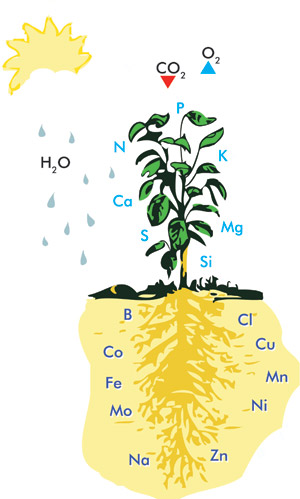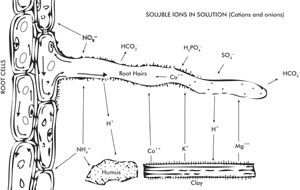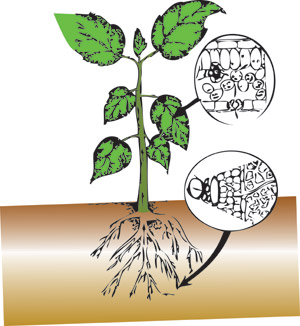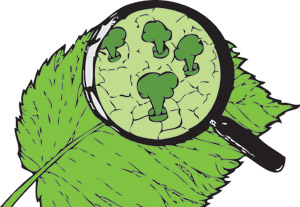
The movement of solution through the plant is dictated by a complex combination of internal and external forces

A view of the plant environment.
|
The movement of solution through the plant is dictated by a complex combination of internal and external forces
The subject of mineral nutrition covers such a broad field of topics, trying to compress all information into one article would not do justice to such an important subject.
My objective is to create a series of technical features that will explore individual topics that are related to mineral nutrition of plants. Upon completion of these articles, one will be able to see how each topic can affect a plant’s response to nutrient availability and should be understood prior to developing an effective nutrient management program.
This first feature will begin at the initial site of mineral uptake, that being the root/soil environment. Simply stated, most of the nutrients a plant desires are dissolved in a water/soil solution surrounding the roots. In the case of peat, as an organic matter, it can hold large amounts of water, which helps elements move from the soil towards the roots. Nutrients come into contact with the root surface and the roots act as interceptors providing pathways for selected solutions and substances into the plant’s circulatory system.
HOW REMOTE ELEMENTS FIND THEIR WAY TO THE ROOTS
As we briefly examine the root environment, we will quickly review the actual movement of nutrients in and around the media as it approaches the root surface. What are the driving forces that allow elements in remote areas of the soil to find their way to the roots?

Most of the nutrients a plant desires are dissolved in a water/soil solution surrounding the roots.
|
For simplicity’s sake, at this time I will only refer to transpiration as one of the main factors in providing the inertia for the movement of nutrients towards and into the roots. As a plant transpires or loses water through its leaf surface, water loss dictates a demand for uptake of solution from the root/soil environment. This triggers the process of mobilization of nutrients through the soil and towards the root surface.
This process of mobilization is associated with two principles of fluid dynamics, which we will not go into with any great detail. Water moves towards and into the root in response to a plant’s utilization of water and the process of transpiration. This process is simply referred to as a mass flow and accounts for a substantial movement of solution towards the roots.
UNDERSTANDING THE DIFFUSION PROCESS
The other process associated with movement of fluids is referred to as diffusion, which is the process where chemicals move from an area of high concentration to an area of low concentration. Again as a plant transpires, roots take up nutrients that create a zone directly next to the root that has a low concentration of salts. This allows diffusion to occur, which pulls elements in solution that are farther away from the root zone closer to the immediate root surface.

The main circulatory system. Xylem and phloem bundles guide solutions through the plant’s roots and stem.
|
Now that we have an idea of the movement of nutrient-enriched solutions in and around the root zone, I will briefly examine the mobility of elements into the plant. As previously mentioned, the root absorbs aqueous substances and transports them into the plant’s main circulatory system. There is no reason at this time to go into any lengthy discussion of the plant’s vascular system. Simply stated, xylem and phloem bundles guide solutions through the plant’s roots and stems. The xylem channels solutions up into the plant and the phloem primarily distributes manufactured foods throughout the plant.
It would seem that mineral uptake into the plant is a relatively straightforward process. However, at this point in time, it is important to realize a lot must happen before a chemical element supplied in a nutrient solution can be taken up and used by the plant. For optimum growth, adequate water and oxygen must be available in the soil. Oxygen is required in the soil for respiration to occur to produce energy for growth and movement of mineral ions into the root cells. Without oxygen from the soil environment there is no energy produced for nutrient absorption.
A COMPLEX COMBINATION OF INTERNAL AND EXTERNAL FORCES
Another important factor that will be highlighted throughout many of the subsequent articles will be the actual mobility or lack of mobility of nutrients in the soil as well as in the plants. The movement of solution through the plant is dictated by a complex combination of internal and external forces. Many factors play a role in moving solutions through the plant’s circulatory system.

|
As stated before, this article is the introduction to a series of articles that will explore in depth but in a simplified manner, those external and internal forces at work to either positively or negatively affect the mobilization and absorption of essential elements into the plant. As a grower, you will be better equipped with knowledge that will be very useful in diagnosing problems related to nutrient deficiencies triggered by antagonistic as well as environmental factors.
Print this page